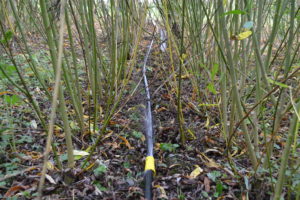Biofiltration using Short Rotation Coppice (SRC) Willows – a Win, Win, Win!
Are you involved in an industrial process that results in large volumes of effluent that needs treatment?
Are you looking to cut your tankering or disposal costs?
Do you have access to farmland?
If the answer to these three questions is yes then you should be considering the opportunity of planting a crop of short rotation coppice (SRC ) willows to provide a biofiltration solution.
SRC willows are very fast growing shrubby trees planted at high densities (15,000 per hectare) that transpire large volumes of water each year. You could potentially save £££ by applying the wastewater from your industrial process across the growing crop instead of keeping it in expensive aeration facilities or tankering it offsite.
Willows are highly versatile trees that can tolerate high concentrations of nitrogen, phosphorous and potassium (NPK) and heavy metals (such as cadmium, zinc and copper). In many situations the crop thrives from the periodic irrigation with process effluent and can produce high biomass yields. The willow can be harvested every 2-3 years and used in power stations or biomass boilers.
How it works:
- You need to get your effluent analysed so that you know what concentrations of NPK and heavy metals you are dealing as well as the pH
- Based on this analysis you can size your plantation according to the concentrations and the amount of effluent you are dealing with.
- You would need to share your ideas with the Environment Agency In England (SEPA in Scotland, Natural Resources Wales and the Northern Ireland Environment Agency) at an early stage and make sure you apply for the correct permits.
- You would prepare the land in the autumn and plant the SRC the following spring.
- The crop is cut back after the first year. At this point you can install the pumps and main pipelines and lay the irrigation pipes within the double rows of the growing crop.
- From late spring of the second growing year you should be able to start applying the wastewater.
SRC has been used in this way to treat landfill leachate, distillery waste, brewery waste, waste water from pea processing, municipal waste water and many other applications.
If you would like to discuss your project we would be interested to hear from you. Crops for Energy and our partners Laqua can help you with:
- An initial economic and logistical feasibility study calculating the amount of land required, the system cost and potential savings
- Design a plantation and pipework and pump assembly
- Assist in the permitting process
- Manage the land preparation and SRC planting
- Provide the best willow varieties at competitive prices
- Provide a quote for the piping and pumping infrastructure and installation
- Ongoing monitoring and advice.
And just to recap on the triple win:
- You could get rid of your problem on site with a low cost solution. Once set up there are very small overheads.
- You could save massively on treatment costs and tankering costs if you are transporting the wastewater elsewhere
- You recycle the waste product into a fast growing biomass crop which can be sold as a biomass feedstock.
